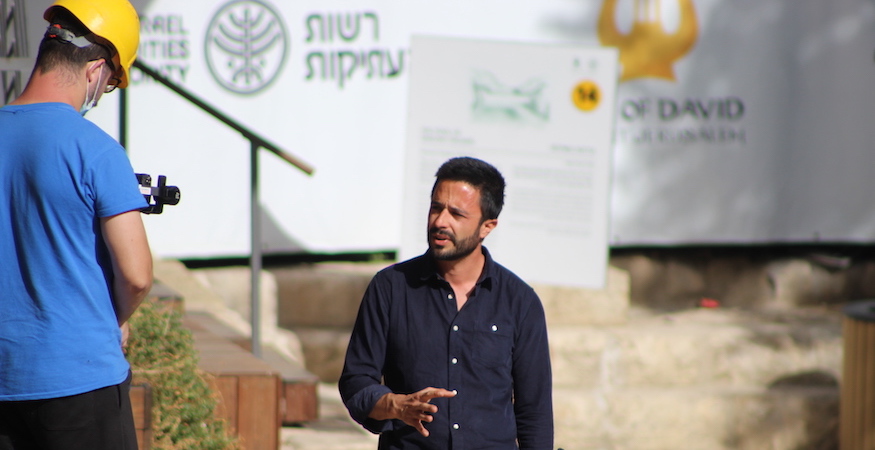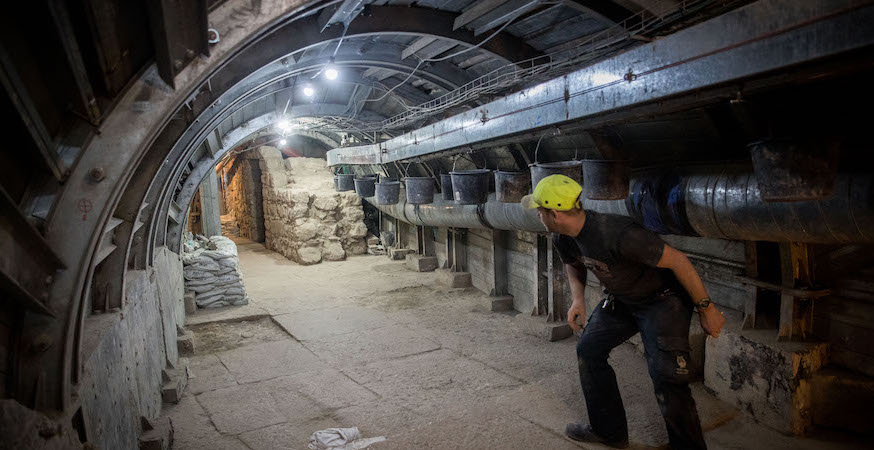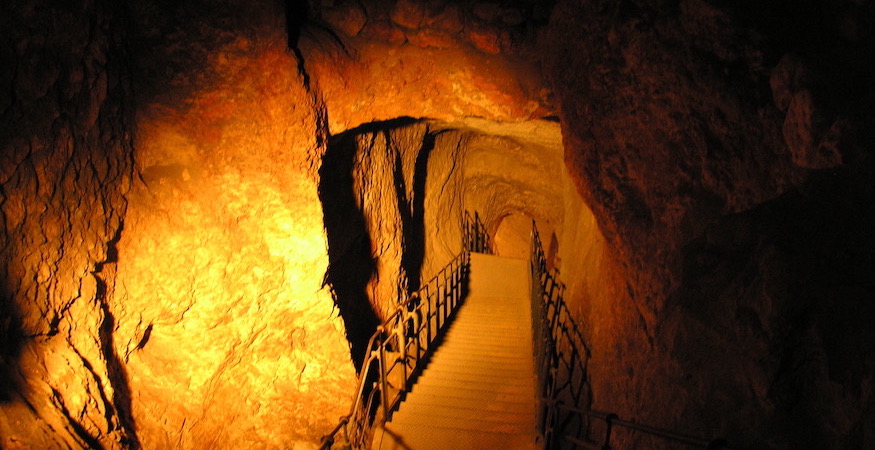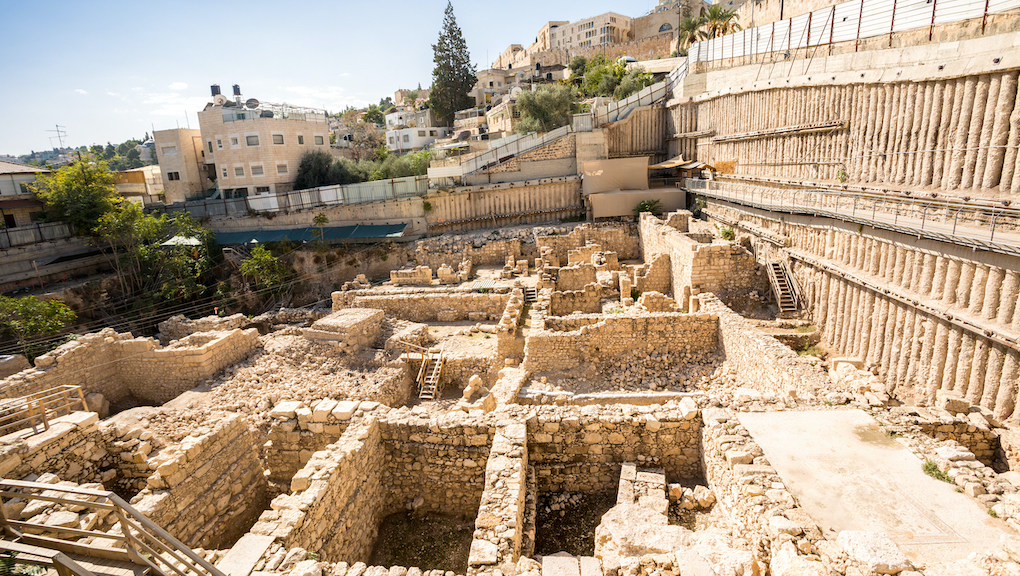The Pilgrimage Road – Going up to Jerusalem
City of David
The ‘City of David’ is the location of the Biblical city of Jerusalem captured by King David over 3,000 years ago. Located to the south of the Temple Mount, here David built his first city, before the Temple was built by his son Solomon. And according to the Bible (1 Kings 2:10), David was buried in the City of David (not Mount Zion, where there is now a tomb of David).
The original City of David basically lay hidden for many centuries after the destruction of the Second Temple in 70AD, and began to be rediscovered in the 19th century. Today it is still being excavated. As excavations are completed, the area is opened to tourism to further deepen visitors’ understanding of its past.
One of the sites that has been recently rediscovered is the ‘stepped street’, as it’s known from academic works, or the ‘Jerusalem Pilgrim Road’ as it has been dubbed by the City of David administration – the Late Roman period street connecting the Temple Mount from its southwestern corner, to Jerusalem’s southern gates of the time via the Pool of Siloam. The Road is still being excavated, and is closed to the public; it is expected to be open within the next year.
The Pool of Siloam became an important ritual bath, and source of water – King Hezekiah built the pool when he created an ingenious tunnel to divert water from the Gihon Spring, outside the city walls, to the Pool of Siloam (2 Chronicles 32).

Below: Moshe Gabay, director of Keshet Journeys, during filming of the Pilgrimage Road video. | Photo: Keshet Journeys
Construction of the Road
National Geographic reports that historians previously thought it was the Roman-appointed King Herod the Great who approved most of the large construction projects that remade ancient Jerusalem into a major pilgrimage and tourist centre. But a recent analysis of more than 100 coins found beneath the stepped street point to the start and completion of the effort under Pontius Pilate, who ruled for about a decade starting in 26 or 27 AD. In other words, it was the Roman governor responsible for condemning Jesus of Nazareth to death by crucifixion, who ordered the construction of a street for pilgrims to follow to the Jewish Temple more than 2,000 years ago.

A worker walks at the Pilgrimage Road at the City of David, in the East Jerusalem neighborhood of Silwan, on January 6, 2020. Photo by Yonatan Sindel/Flash90
The latest coins discovered beneath the paving stones date to around 31 AD. The most common Jerusalem coins from the first century were minted after 40 AD, “So not having them beneath the street means the street was built before their appearance, in other words only in the time of Pilate,” Donald Ariel, a coin expert with the Israel Antiquities Authority, told the magazine.
The Road took ten years for the Romans to build. When it was completed, it was about half a kilometer long and measured 10 meters wide. More than 10,000 tons of limestone were used in its construction.
The Pilgrimage Road was travelled by Jewish pilgrims obeying the Biblical commandment to travel to Jerusalem three times a year for a Temple sacrifice – at Passover, Shavuot (Pentecost), and Succoth (Feast of Tabernacles).
Zeev Orenstein, Director of International Affairs at the City of David Foundation: “For Jews in ancient days, their pilgrimage began at the Pool of Siloam, a giant mikveh, or ritual bath, the size of two Olympic swimming pools. Pilgrims would purify themselves here before going up to the Temple to offer their sacrifices.”
Special Significance of the Pilgrimage Road for the Church
According to Moshe Gabay, Director of Keshet Journeys, the Pilgrimage Road has special significance for Christians. “Gentiles also had access to the Temple, so they too would have cleansed themselves in the mikveh and climbed the Pilgrimage Road from the Pool of Siloam to the Temple. It is important to remember: the Temple was a place where both Jews and Gentiles could worship the one God, the God of Abraham, Isaac and Jacob.”
“By Jesus’ time, the City of David had become a poorer part of Jerusalem; richer people lived in what is now the Old City of Jerusalem. Because the Pool of Siloam was a public bath, it attracted many people. So it is no surprise this is the place where Jesus healed the blind man.
”As long as it is day, we must do the works of him who sent me. Night is coming, when no one can work. While I am in the world, I am the light of the world.” After saying this, he spit on the ground, made some mud with the saliva, and put it on the man’s eyes. “Go,” he told him, “wash in the Pool of Siloam” (this word means “Sent”). So the man went and washed, and came home seeing. John 9:4-7
Gabay: “The Pool of Siloam was also an important place during the Feast of Tabernacles. Here, the Jews took water up to the Temple, as the Feast of Tabernacles was the time when they started to pray for rain. They recited the words of Isaiah 12:3 – ‘With joy, you will draw water from the wells of salvation’. So it is very significant that when Jesus comes to Jerusalem to celebrate the Feast of Tabernacles, He applies Isaiah’s words about physical water to Himself as spiritual water”:

The tunnel system that was used by the inhabitants of the city in Biblical times to reach the Gihon Spring, and through which the water from the spring flowed to the Pool of Siloam later on, guarantees an adventurous outing in Jerusalem. | Photo: Shutterstock
“The Pool of Siloam is also quite probably the place where 3000 people were baptised on the day of Pentecost – the day the church was born”, Gabay explains. “It is likely that the disciples spent the days after Jesus’ Ascension in the City of David. When Shavuot, the Day of Pentecost, came, the Jews were gathered near the Temple in huge numbers. They stayed up all night preparing themselves to go up to the Temple for the Feast. It is possible that when Peter preached on the Day of Pentecost, as recorded in Acts 2, this would have been on the Pilgrimage Road. Many people would have been gathered in this area due to the ending of their Pentecost prayers, because the lower City of David is where the poor people lived. And Peter in his preaching specifically refers to David being buried there.
“On the last and greatest day of the festival, Jesus stood and said in a loud voice, “Let anyone who is thirsty come to me and drink. Whoever believes in me, as Scripture has said, rivers of living water will flow from within them.” By this he meant the Spirit, whom those who believed in him were later to receive. Up to that time the Spirit had not been given, since Jesus had not yet been glorified.” John 7:37-39
The Pool of Siloam, at the bottom of the road, is also the only place where 3000 people could have been baptised at once. Then they would have ascended to the Temple via the Pilgrimage Road, singing the Songs of Ascent. Isn’t that beautiful? And now, after 2000 years, we will soon be able to walk these steps ourselves.”
The City of David
The excavations south of the Temple Mount on the Ophel, where the City of David once was, are fascinating. Among other things, they show how the inhabitants of the city got access to water by ingeniously moving the water from the lower Gihon Spring to the Pool of Siloam. King Hezekiah dug a tunnel through the mountain to secure the water, and tourists can still wade through there today. An encounter with Biblical times.
 With Special Thanks
With Special ThanksTo Moshe Gabay, Director of Keshet Journeys. Keshet Journeys offers quality educational tour programmes in Israel. Find out more at www.keshetjourneys.com




